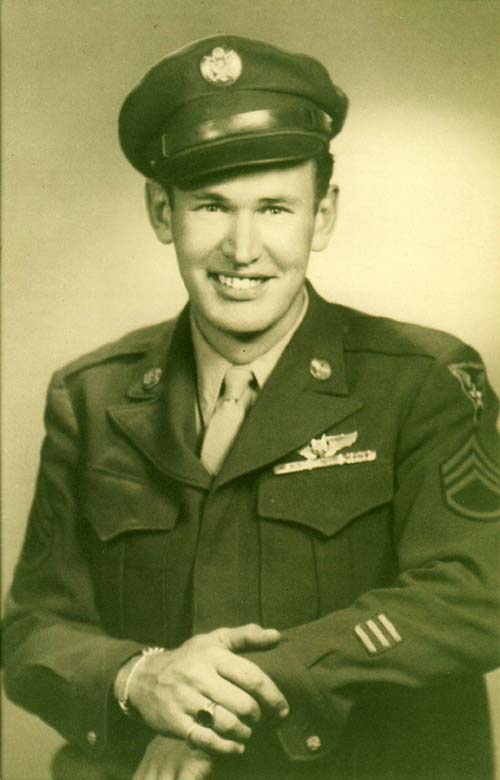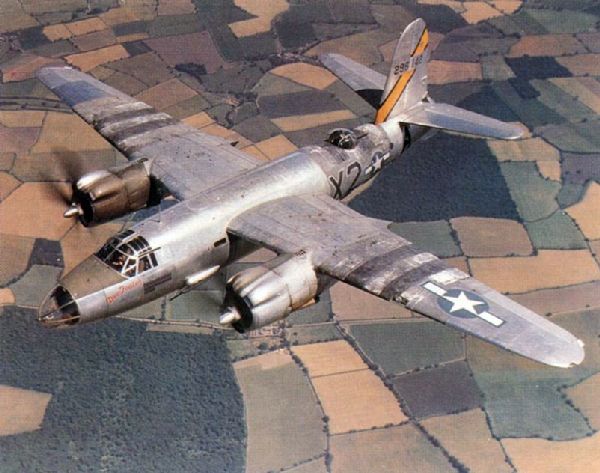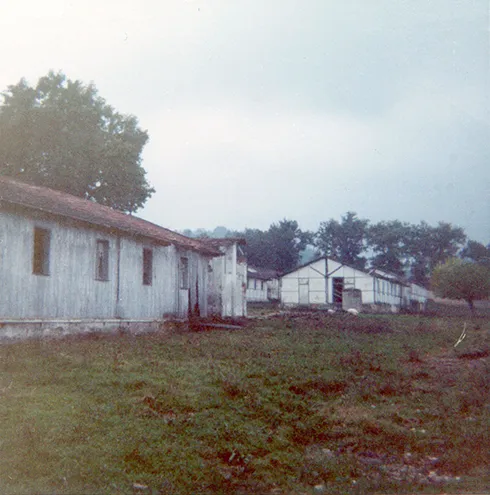
William P. Hancock Jr. World War II Experience
By Michael A. Dow – January, 2023
William P. Hancock Jr. was born in York Hospital on December 28, 1921 and graduated from York High School with the class of 1939.
When Pearl Harbor was bombed by the Empire of Japan on December 7, 1941, Colby College student William P. Hancock and the rest of America was thrown into the Second World War. Hancock did what many young men of that time did by dropping out of college and enlisting in the U.S. Army Air Corps. Rejected as a pilot because his eyes were not quite good enough, he became an aerial gunner.
Hancock was assigned to the 320 Bombardment Wing in North Africa. He flew 22 successful missions over Italy, Sardinia and Sicily as a dorsal gunner in a Martin B-26 Marauder with most of the later missions designed to lay the groundwork for the allies’ intended landing at Taranto and Selarno.

Shot Down
On his 23 mission and in a new B-26 Marauder, Hancock experienced problems with his twin turret mounted .50 cal. machine guns. “I’d shoot a few rounds and one gun would jam, I’d shoot a few rounds with the other and that would jam. I got it working again, but they just kept jamming. First thing I knew they got us. I heard a thump-thump and our right engine was on fire. The minute I saw it, I knew we had had it.”
After having some serious difficulty securing his equipment and extracting himself from the small, terminally wounded bomber, Hancock finally got out and deployed his parachute. His aircraft was one of four B26’s shot out of the sky by the Luftwaffe on 21 August, 1943 and he remembered; “There were so many parachutes in the air over Villa Literno that it looked like a bunch of paratroopers on a mission.” He was one of 24 airmen who safely landed. Hancock remembered that; “I never saw one of them after that,” he said. “Not in prison camp, not anywhere.”
On the Ground
Staff Sgt. Hancock landed hard in a plowed field that had hedge rows as boarders. Concealing his parachute as well as terrain allowed he tried to do the same by spending the night under a tree, rather than the hedgerows that surrounded the field. Not immediately noticing the pain in his ribs; “I looked at my sweater; I looked at my jacket, and said, “Oh, I’ve been shot.” The wound turned out to be shrapnel that Italian doctors removed a few days later. “You can’t imagine what it was like,” Hancock recalls. “It was pitch black, dogs were barking. I didn’t know where I was and I needed water.”
Moving south through the Italian countryside, hoping to reach the coast and a night time submarine rescue, he found a well in a vineyard. But, a woman with a child had seen him and being seen in Hancock’s situation is never a good thing. Finding a place to rest nearby, he soon fell asleep.
Sergeant Hancock did not speak German and neither did the Italian police officer with the rifle who was standing close by him when he woke up. However, the dark uniformed officer was able to convey a message in his native tongue that convinced Hancock he was being asked if he were a German soldier. “Si” was one of the few words in Italian the airman knew and employed in this instance. His short answer was apparently good enough. “He went off one way and I the other. He thought I was a German” as Hancock remembered.
Gaining confidence of his very limited skills in Italian and being able to make better time by day rather than by night, he once again headed south. “I’d meet Italians during the day, and I would say ‘Bon jiorno’ and they would say ‘Bon jiorno.’ ” This worked well until he met a German speaking Italian. “That cooked me,” Hancock remembered.
Captured
Staff Sergeant William Hancock was taken prisoner and delivered to a POW Camp 66 near Naples where; “The men looked like galley slaves with their torn cloths and blank stares when I entered. I saw that of the 3,000 men, I was the only one with a complete uniform.”
This camp was near three airfields and a railroad station, all of which were holding the attention of the US Airforce. “Most of the fellows were extremely jumpy, not so much from the treatment they were getting as from fear of the continuous bombardments,” he said.


In less than a week, Hancock was moved to another POW Camp 59 on the east coast and some distance from the airfield, railroad targets.
The Italian Armistice between the Kingdom of Italy and the Allies was signed on September 3,1943 and made public on September 8. German forces had intercepted word of their allies’ betrayal so by the time the Armistice was announced on the radio, they had a plan already to roll and immediately attached and forcibly disarmed any Italian armed forces they met.
Escaped
The agreement called for all prisoners to be turned over to American forces. But Germany’s tight grip on the country made that impossible. On or about September 12, with German troops within 25 miles of the camp where Hancock was held, the camp’s Italian commanding officer told the prisoners they could leave if they wanted. The guards were not informed of this decision and Hancock said; “We had to fight our way out.” A scuffle followed until the commander made an announcement over the camp’s public address system and no one was injured.”
Hancock and several prisoners went to the hills and stayed in caves with the help of the now friendly Italian farmers. After a month, he and four others decided to “strike out” for American lines and headed south seeking allied forces.
Captured Again
“One of our boys became sick after several days of traveling and when we sought aid at one of the farmhouses, a civilian Fascist reported us to the Germans.” German Paratroopers captured Sgt. Hancock and another man on or about October 5, 1943 and they were put into trucks in a German Convoy.
On September 9th, the Allies had landed troops at Salerno and at Taranto and their advances were bogged down in terrain that favored the prepared and entrenched German troops. As a result, the Allied forces took 20 months to reach the northern borders of Italy.
York had three, first cousins who participated in WWII with Staff Sergeant William Hancock being the lone survivor. PFC Eugene T. Boardman’s regiment was deeply involved in the Battle of Lajatico in the Province of Pisa in the Tuscany region of Italy and was killed in action during that battle on July 12, 1944. He was 20 years old. Lieutenant Junior Grade (LT/jg), Richmond H. Ellis was a submariner and his Portsmouth Naval Yard built boat, the Scorpion was reported as “presumed lost” on March 6, 1944. Nearly two years later on January 11, 1946 Richmond was officially declared deceased by the military. He was 25 years old.
William Hancock’s first cousins Gene Boardman and Richie Ellis are both honored with Fallen Hero street banners in York Village.
Thinking of Escaping Again
Having been put into a convoy truck carrying fuel and explosives by German paratroopers and while enroute to yet another POW camp, the convoy was bombed and staffed by American P51 fighters. Hancock remembers seeing tracers fired from the fighter planes rushing up the road on either side of him as he dove from the truck and rolled into the ditch, seeking cover and hiding in a culvert. Hancock remembered that; “I was thinking of getting away.” But his wounds and German troops quickly changed his mind. “There was no question in my mind that the Germans were going to shoot me.”
Hancock, with a shrapnel wound to his throat and legs and a rock buried in one leg, was one of the few convoy survivors. Luckily, the truck in which Hancock was riding suffered little damage. “Thank God they didn’t hit us, he said. We’d have blown sky high.” He ended up in an “Italian Civil Hospital” in Rieti, Italy for six weeks and from there to a German field hospital for two weeks. In 1975 Hancock accompanied by his wife Alma and a couple of friends, returned to Italy on a vacation and reunited with the nurse’s aide that had attended to him in that hospital.
Dinner with a German Field Martial
On Christmas eve, 1943 a German field Martial had 30 to 40 Americans POW’s, including Staff Sergeant Hancock, trucked to Rome for Christmas dinner. Hancock said this overtly humane act was one of pure propaganda designed to show the qualities of care American POW’s were extended.
Escaped Again
William Hancock well remembered what happened on December 28, 1943 because it was his 22nd birthday. On that day he and other American POW’s were loaded onto a train. “They loaded us in boxcars headed for Germany. They had searched us thoroughly but somehow we managed to sneak through a wire cutter. We used this tosnip an opening in the barbed wire and when we saw that all was clear, we pushed the boys out. We jumped off the train and made our way across the field. It was too dark for them to make a thorough search.”
Captured Again
Hancock and two others headed toward the Cassino Line. With rural Italian families providing food and shelter they managed to elude the Germans for four months! On April 6, 1944 they were once again captured and interred with about 20 Italians in a prison camp near Arezzo. After many stops in local jails and small POW camps they ended up in a much larger facility.
Earlier in his interments, Staff Sergeant William Hancock became acquainted with a German captain who spoke good English. After his successful escapes and recaptures, he once again met up with the same German officer. The captain told Hancock how much he admired his elusive qualities. He also frankly told Hancock that he would be shot if caught trying to escape again but if he did get away and make it home, he wished Hancock well.
Last Escape
After being transferred to a German POW Camp 82 in Laternia, about 30 miles south of Florence, they found themselves in the company of around 4,000 other Americans. Allied forces were on the move and had broken out of Anzio and the Cassino Line and were advancing up through Italy. Trying to keep ahead of the allied forces, on or about June 18, 1944 the Germans began evacuating this camp and having no transportation the prisoners were to be marched north.
The following are Staff Sergeant Hancock’s own words of his last and most daring escape from German forces in Italy in mid1944.
“A fellow prisoner and I hid in a small tree within the camp and after a long, difficult night we managed to escape and head south towards our lines once more.”
“After the Germans had searched the grounds they came in and threw hand grenades in various corners of the building – just in case anyone was hiding,”
“At one point some German guards stood directly below us and if they had looked up they couldn’t have avoided seeing us.”
Later in life, Hancock would relate to his close friends another part of this story he did not cover in previous interviews. During that “long, difficult night,” Hancock became aware that nature was demanding he relieve himself. Both men were afraid that the sound and sight of a stream of liquid falling from the only tree in the middle of the POW camp yard would draw unwanted attention from the German guards. The urgency of the moment required Hancock to once again utilize his now tried and tested creative problem solving abilities. He slowly and with great deliberation allowed a small and much regulated stream trickle its way down the trunk of that lone tree.
Climbing down in the morning, the two young men walked out of the camp. After a short time they became caught between advancing Allied artillery and the retreating Germans. ‘’Every once in a while a short round would come right near us.” Hancock related.
They moved into the hills and met up with Italian partisans who helped them. After about two weeks they were taken to a village near Siena which was occupied with South African troop and finally made their way to American Forces in North Africa.
During his 11 month adventure in Italy, Hancock had no communication with his parents. His dad continued to write to his son all during Sgt. Hancock’s incarceration but never got a response. According to one newspaper report, his parents had been notified by the Red Cross that he was prisoner of the Italians with later information indicated he was in Germany. All they knew for sure was their son was missing in action.
Hancock did not know his mom and dad had recently purchased the Ogunquit Pound. So, when he landed in New York City he tried to call home and got no answer. Hancock called his parent’s best friends, Harry and Doris Hutchins, found out about the lobster pound, got the business number and made the call. Bill’s mom Hazel answered the phone and when she heard his voice, she fainted.
After first going to Washington for debriefing, Hancock received a well-earned, 21 day furlough. Reporting back for duty, Staff Sargent William P. Hancock of York, Maine, was assigned an interesting duty which no doubt called upon his great resources of mission focus. He became a recruiter for the WAC’s (Woman’s Army Corps).
In 1948, Hancock became a Trooper for the Maine State Police and in 1970, retired as a captain after 22 years. He also served as an agent for the New England Organized Crime Intelligence System from 1970 to 1974 and further served as the Chief of Police of Ogunquit, Maine for another 20 years.
At some point in the 1970’s Bill and an Italian speaking friend went to Italy and reunited with the Italian nurse who took care of him when he was injured and in the Italian hospital. He also visited the house where an Italian family had given him shelter and sustenance during the war at great risk to themselves.
Willian P. Hancock passed away peacefully on July 6, 2008 after a very full life.
Sources
S-Sgt. Hancock Tells Of Escaping 3 Times from NAZI PW Camps
by Portsmouth Herald staff writers. Friday June 25, 1945
Ogunquit chief reflects on war experience
by Jerry Fraser, York Weekly Bureau Chief; circa 1990
Former Ogunquit Police Chief Recalls Harrowing Time as a POW during WWII
by Stuart Nudelman Tourist news; May 18, 1995
York Man Reaches US After Escape from Nazi’s
by Portsmouth Herald staff writers, July 20, 1944
William P. Hancock II provided two, undated military resumes, from different times.
Old York Historic provided the 1939 York High School yearbook picture and an undated audio interview by granddaughter Megan Whittle.
Interviews with William Hancock’s children Lisa, Bill and nephew Josh Hancock.
